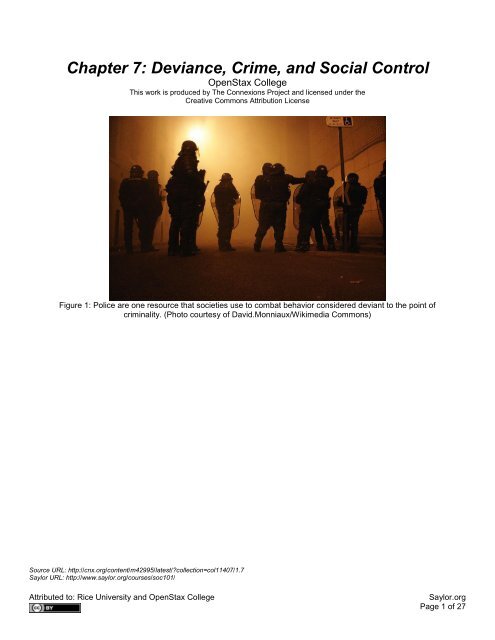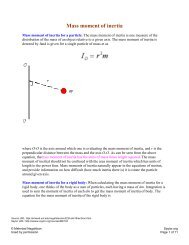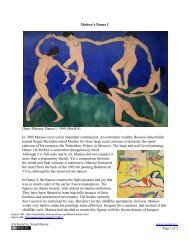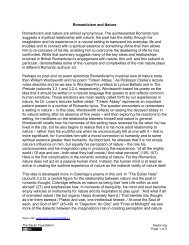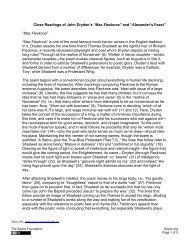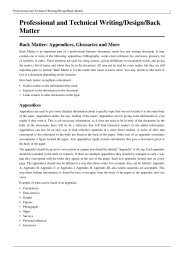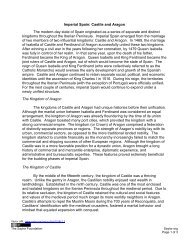Chapter 7: Deviance, Crime, and Social Control - Saylor.org
Chapter 7: Deviance, Crime, and Social Control - Saylor.org
Chapter 7: Deviance, Crime, and Social Control - Saylor.org
You also want an ePaper? Increase the reach of your titles
YUMPU automatically turns print PDFs into web optimized ePapers that Google loves.
<strong>Chapter</strong> 7: <strong>Deviance</strong>, <strong>Crime</strong>, <strong>and</strong> <strong>Social</strong> <strong>Control</strong><br />
OpenStax College<br />
This work is produced by The Connexions Project <strong>and</strong> licensed under the<br />
Creative Commons Attribution License<br />
Figure 1: Police are one resource that societies use to combat behavior considered deviant to the point of<br />
criminality. (Photo courtesy of David.Monniaux/Wikimedia Commons)<br />
Source URL: http://cnx.<strong>org</strong>/content/m42995/latest/?collection=col11407/1.7<br />
<strong>Saylor</strong> URL: http://www.saylor.<strong>org</strong>/courses/soc101/<br />
Attributed to: Rice University <strong>and</strong> OpenStax College<br />
<strong>Saylor</strong>.<strong>org</strong><br />
Page 1 of 27
7.1 Introduction to <strong>Deviance</strong>, <strong>Crime</strong>, <strong>and</strong> <strong>Social</strong> <strong>Control</strong><br />
Philip Hudson entered Morehouse College at age 19 wearing men’s jeans <strong>and</strong> long hair<br />
tied back in dreadlocks. “The first day I got to campus, I was a boy,” Philip recalled a<br />
few years later. He said he was “trying to be this masculine boy, real cool <strong>and</strong> real<br />
quiet.” By the end of his sophomore year, Philip had swapped his jeans for skirts <strong>and</strong><br />
found himself the target of a strong backlash (King 2010). Morehouse College made<br />
national news for its response to the teen’s lifestyle, establishing a schoolwide ban on<br />
the wearing of women’s clothing by men (Chen 2010).<br />
Morehouse College, an all-male college in Atlanta, Ge<strong>org</strong>ia, has a prestigious history.<br />
Established in 1867 as a place of higher learning for former slaves, Morehouse is the<br />
alma mater of great leaders such as “Dr. Martin Luther King, Jr. <strong>and</strong> Howard Thurman,<br />
<strong>and</strong> celebrities such as Samuel L. Jackson <strong>and</strong> Spike Lee” (Mungin 2009). The sense of<br />
revolution is what brought Philip to Morehouse, a place where he hoped he could be<br />
himself.<br />
After a difficult upbringing where his gendered-ness resulted in abuse <strong>and</strong> rape, he<br />
realized that he identified as a female <strong>and</strong> wanted to express that aspect of his person.<br />
He began taking female hormones to start his biological transition to the female sex.<br />
Although Philip initially halted his treatment once he began college, he soon found<br />
others like himself. At Morehouse, he met Diamond Poulin, a student who defined<br />
himself as a man who felt comfortable in women’s clothes. Joined by a h<strong>and</strong>ful of<br />
others, Philip <strong>and</strong> Diamond donned skirts, high heels, <strong>and</strong> other traditionally female<br />
attire on campus in an attempt to be themselves. They were jeered at <strong>and</strong> ridiculed –<br />
even attacked.<br />
Then came the school’s shocking decision in late 2009. The new rules, titled the<br />
“Appropriate Attire Policy,” banned cross-dressing anywhere on the campus grounds.<br />
Those who broke the rules were not allowed to attend class unless they changed their<br />
clothing, <strong>and</strong> multiple transgressions led to disciplinary action <strong>and</strong> suspension.<br />
Diamond left Morehouse that fall, but returned once in the spring to visit his friends. He<br />
found himself escorted off campus by school security for violating the dress code. Philip<br />
remained at Morehouse for another year before leaving because of stress. He now<br />
plans to resume his studies at a larger university in Florida. What he’s most looking<br />
forward to is walking around in public without being verbally attacked. “They’ll stare,”<br />
Philip says with resignation, “but I’m used to that” (King 2010).<br />
References<br />
Chen, Stephanie. 2010. “Male, Female or Neither? Gender Identity Debated at Samesex<br />
Colleges.” CNN, November 8. Retrieved February 10, 2012 (http://www.cnn.com<br />
/2010/LIVING/11/08/single.sex.college.trangender.nongender/index.html).<br />
Source URL: http://cnx.<strong>org</strong>/content/m42995/latest/?collection=col11407/1.7<br />
<strong>Saylor</strong> URL: http://www.saylor.<strong>org</strong>/courses/soc101/<br />
Attributed to: Rice University <strong>and</strong> OpenStax College<br />
<strong>Saylor</strong>.<strong>org</strong><br />
Page 2 of 27
King, Aliya S. 2010. “The Mean Girls of Morehouse.” Vibe, November 10. Retrieved<br />
February 10, 2012 (http://www.urbanlife<strong>and</strong>style.com/index.php?option=com<br />
_content&view=article&id=1456&joscclean=1&comment_id=255&Itemid=221).<br />
Mungin, Lateef. 2009. “All-Male College Cracks Down on Cross-dressing.” CNN,<br />
October 17. Retrieved February 10, 2012<br />
(http://www.cnn.com/2009/US/10/17/college.dress.code/index.html?iref=allsearch).<br />
7.2 <strong>Deviance</strong> <strong>and</strong> <strong>Control</strong><br />
Summary:<br />
Define deviance <strong>and</strong> explain the nature of deviant behavior<br />
Differentiate between methods of social control<br />
Figure 2: Much of the appeal of watching entertainers perform in drag comes from the humor inherent in<br />
seeing everyday norms violated. (Photo courtesy of Cassiopeija/Wikimedia Commons)<br />
What, exactly, is deviance? And what is the relationship between deviance <strong>and</strong> crime?<br />
As Philip Hudson found out, some behaviors, such as wearing clothes of the opposite<br />
sex, can be deviant in certain places, criminal in some places, <strong>and</strong> perfectly acceptable<br />
elsewhere. According to sociologist William Graham Sumner, deviance is a violation of<br />
established contextual, cultural, or social norms, whether folkways, mores, or codified<br />
law (1906). It can be as minor as picking one’s nose in public or as major as committing<br />
murder. Although the word “deviance” has a negative connotation in everyday<br />
language, sociologists recognize that deviance is not necessarily bad (Schoepflin 2011).<br />
In fact, from a structural functionalist perspective, one of the positive contributions of<br />
deviance is that it fosters social change. For example, during the U.S. civil rights<br />
movement, Rosa Parks violated social norms when she refused to move to the “black<br />
Source URL: http://cnx.<strong>org</strong>/content/m42995/latest/?collection=col11407/1.7<br />
<strong>Saylor</strong> URL: http://www.saylor.<strong>org</strong>/courses/soc101/<br />
Attributed to: Rice University <strong>and</strong> OpenStax College<br />
<strong>Saylor</strong>.<strong>org</strong><br />
Page 3 of 27
section” of the bus, <strong>and</strong> the Little Rock Nine broke customs of segregation to attend an<br />
Arkansas public school.<br />
“What is deviant behavior?” cannot be answered in a straightforward manner. Whether<br />
an act is labeled deviant or not depends on many factors, including location, audience,<br />
<strong>and</strong> the individual committing the act (Becker 1963). Listening to your iPod on the way<br />
to class is considered acceptable behavior. Listening to your iPod during your 2 o’clock<br />
sociology lecture is considered rude. Listening to your iPod when on the witness st<strong>and</strong><br />
before a judge may cause you to be held in contempt of court, <strong>and</strong> consequently fined<br />
or jailed.<br />
As norms vary across culture <strong>and</strong> time, it makes sense that notions of deviance change<br />
also. Fifty years ago, public schools in the United States had strict dress codes that,<br />
among other stipulations, often banned women from wearing pants to class. Today, it’s<br />
socially acceptable for women to wear pants, but less so for men to wear skirts. In a<br />
time of war, acts usually considered morally reprehensible, such as taking the life of<br />
another, may actually be rewarded. Whether an act is deviant or not depends on<br />
society’s response to that act.<br />
Why I Drive a Hearse:<br />
When sociologist Todd Schoepflin ran into his childhood friend Bill, he was shocked<br />
to see him driving a hearse. A professionally trained researcher, Schoepflin<br />
wondered what effect driving a hearse had on his friend <strong>and</strong> what effect it might have<br />
on others on the road. Would using such a vehicle for everyday err<strong>and</strong>s be<br />
considered deviant by most people?<br />
Schoepflin interviewed Bill, curious first to know why he drove such an<br />
unconventional car. Bill had simply been on the lookout for a reliable winter car; on a<br />
tight budget, he searched used car ads <strong>and</strong> stumbled upon one for the hearse. The<br />
car ran well <strong>and</strong> the price was right, so he bought it.<br />
Bill admitted that others’ reactions to the car had been mixed. His parents were<br />
appalled <strong>and</strong> he received odd stares from his coworkers. A mechanic once refused<br />
to work on it, stating that it was “a dead person machine.” On the whole, however,<br />
Bill received mostly positive reactions. Strangers gave him a thumbs-up on the<br />
highway <strong>and</strong> stopped him in parking lots to chat about his car. His girlfriend loved it,<br />
his friends wanted to take it tailgating, <strong>and</strong> people offered to buy it. Could it be that<br />
driving a hearse isn’t really so deviant after all?<br />
Schoepflin theorized that, although viewed as outside conventional norms, driving<br />
a hearse is such a mild form of deviance that it actually becomes a mark of<br />
distinction. Conformists find the choice of vehicle intriguing or appealing, while<br />
nonconformists see a fellow oddball to whom they can relate. As one of Bill’s friends<br />
remarked, “Every guy wants to own a unique car like this <strong>and</strong> you can certainly pull it<br />
off.” Such anecdotes remind us that although deviance is often viewed as a violation<br />
of norms, it’s not always viewed in a negative light (Schoepflin 2011).<br />
Source URL: http://cnx.<strong>org</strong>/content/m42995/latest/?collection=col11407/1.7<br />
<strong>Saylor</strong> URL: http://www.saylor.<strong>org</strong>/courses/soc101/<br />
Attributed to: Rice University <strong>and</strong> OpenStax College<br />
<strong>Saylor</strong>.<strong>org</strong><br />
Page 4 of 27
of norms, it’s not always viewed in a negative light (Schoepflin 2011).<br />
Figure 3: A hearse with the license plate “LASTRYD.” How would you view the owner of this car?<br />
(Photo courtesy of Brian Teutsch/flickr)<br />
<strong>Social</strong> <strong>Control</strong><br />
When a person violates a social norm, what happens? A driver caught speeding can<br />
receive a speeding ticket. A student who wears a bathrobe to class gets a warning from<br />
a professor. An adult belching loudly is avoided. All societies practice social control,<br />
the regulation <strong>and</strong> enforcement of norms. The underlying goal of social control is to<br />
maintain social order, an arrangement of practices <strong>and</strong> behaviors on which society’s<br />
members base their daily lives. Think of social order as an employee h<strong>and</strong>book <strong>and</strong><br />
social control as a manager. When a worker violates a workplace guideline, the<br />
manager steps in to enforce the rules.<br />
The means of enforcing rules are known as sanctions. Sanctions can be positive as<br />
well as negative. Positive sanctions are rewards given for conforming to norms. A<br />
promotion at work is a positive sanction for working hard. Negative sanctions are<br />
punishments for violating norms. Being arrested is a punishment for shoplifting. Both<br />
types of sanctions play a role in social control.<br />
Sociologists also classify sanctions as formal or informal. Although shoplifting, a form of<br />
social deviance, may be illegal, there are no laws dictating the proper way to scratch<br />
one’s nose. That doesn’t mean picking your nose in public won’t be punished; instead,<br />
you will encounter informal sanctions. Informal sanctions emerge in face-to-face social<br />
interactions. For example, wearing flip-flops to an opera or swearing loudly in church<br />
may draw disapproving looks or even verbal reprim<strong>and</strong>s, whereas behavior that is seen<br />
as positive – such as helping an old man carry grocery bags across the street – may<br />
receive positive informal reactions, such as a smile or pat on the back.<br />
Source URL: http://cnx.<strong>org</strong>/content/m42995/latest/?collection=col11407/1.7<br />
<strong>Saylor</strong> URL: http://www.saylor.<strong>org</strong>/courses/soc101/<br />
Attributed to: Rice University <strong>and</strong> OpenStax College<br />
<strong>Saylor</strong>.<strong>org</strong><br />
Page 5 of 27
Formal sanctions, on the other h<strong>and</strong>, are ways to officially recognize <strong>and</strong> enforce norm<br />
violations. If a student violates her college’s code of conduct, for example, she might be<br />
expelled. Someone who speaks inappropriately to the boss could be fired. Someone<br />
who commits a crime may be arrested or imprisoned. On the positive side, a soldier<br />
who saves a life may receive an official commendation.<br />
The table below shows the relationship between different types of sanctions.<br />
Table 1: Informal/Formal Sanctions<br />
Formal <strong>and</strong> informal sanctions may be positive or negative. Informal sanctions arise in social interactions,<br />
whereas formal sanctions officially enforce norms.<br />
Summary<br />
<strong>Deviance</strong> is a violation of norms. Whether or not something is deviant depends on<br />
contextual definitions, the situation, <strong>and</strong> people’s response to the behavior. Society<br />
seeks to limit deviance through the use of sanctions that help maintain a system of<br />
social control.<br />
Further Research<br />
Although we rarely think of it in this way, deviance can have a positive effect on society.<br />
Check out the Positive <strong>Deviance</strong> Initiative, a program initiated by Tufts University to<br />
promote social movements around the world that strive to improve people’s lives, at<br />
http://www.positivedeviance.<strong>org</strong>.<br />
References<br />
Becker, Howard. 1963. Outsiders: Studies in the Sociology of <strong>Deviance</strong>. New York:<br />
Free Press.<br />
Schoepflin, Todd. 2011. “Deviant While Driving?” Everyday Sociology Blog, January 28.<br />
Retrieved February 10, 2012 (http://nortonbooks.typepad.com/everydaysociology/2011<br />
/01/deviant-while-driving.html).<br />
Sumner, William Graham. 1955 [1906]. Folkways. New York, NY: Dover.<br />
Glossary<br />
deviance: a violation of contextual, cultural, or social norms<br />
Source URL: http://cnx.<strong>org</strong>/content/m42995/latest/?collection=col11407/1.7<br />
<strong>Saylor</strong> URL: http://www.saylor.<strong>org</strong>/courses/soc101/<br />
Attributed to: Rice University <strong>and</strong> OpenStax College<br />
<strong>Saylor</strong>.<strong>org</strong><br />
Page 6 of 27
formal sanctions: sanctions that are officially recognized <strong>and</strong> enforced<br />
informal sanctions: sanctions that occur in face-to-face interactions<br />
negative sanctions: punishments for violating norms<br />
positive sanctions: rewards given for conforming to norms<br />
sanctions: the means of enforcing rules<br />
social control: the regulation <strong>and</strong> enforcement of norms<br />
social order: an arrangement of practices <strong>and</strong> behaviors on which society’s<br />
members base their daily lives<br />
7.3 Theoretical Perspectives on <strong>Deviance</strong><br />
Summary:<br />
Describe the functionalist view of deviance in society through four<br />
sociologist’s theories<br />
Explain how conflict theory underst<strong>and</strong>s deviance <strong>and</strong> crime in society<br />
Describe the symbolic interactionist approach to deviance, including labeling<br />
<strong>and</strong> other theories<br />
Figure 4: Functionalists believe that deviance plays an important role in society <strong>and</strong> can be used to<br />
challenge people’s views. Protesters, such as these PETA members, often use this method to draw<br />
attention to their cause. (Photo courtesy of David Shankbone/flickr)<br />
Why does deviance occur? How does it affect a society? Since the early days of<br />
sociology, scholars have developed theories attempting to explain what deviance <strong>and</strong><br />
crime mean to society. These theories can be grouped according to the three major<br />
sociological paradigms: functionalism, symbolic interactionism, <strong>and</strong> conflict theory.<br />
Functionalism<br />
Sociologists who follow the functionalist approach are concerned with how the different<br />
elements of a society contribute to the whole. They view deviance as a key component<br />
Source URL: http://cnx.<strong>org</strong>/content/m42995/latest/?collection=col11407/1.7<br />
<strong>Saylor</strong> URL: http://www.saylor.<strong>org</strong>/courses/soc101/<br />
Attributed to: Rice University <strong>and</strong> OpenStax College<br />
<strong>Saylor</strong>.<strong>org</strong><br />
Page 7 of 27
of a functioning society. Strain theory, social dis<strong>org</strong>anization theory, <strong>and</strong> cultural<br />
deviance theory represent three functionalist perspectives on deviance in society.<br />
Émile Durkheim: The Essential Nature of <strong>Deviance</strong><br />
Émile Durkheim believed that deviance is a necessary part of a successful society. One<br />
way deviance is functional, he argued, is that it challenges people’s present views<br />
(1893). For instance, when black students across the United States participated in “sitins”<br />
during the civil rights movement, they challenged society’s notions of segregation.<br />
Moreover, Durkheim noted, when deviance is punished, it reaffirms currently held social<br />
norms, which also contributes to society (1893). Seeing a student given detention for<br />
skipping class reminds other high schoolers that playing hooky isn’t allowed <strong>and</strong> that<br />
they, too, could get detention.<br />
Robert Merton: Strain Theory<br />
Sociologist Robert Merton agreed that deviance is an inherent part of a functioning<br />
society, but he exp<strong>and</strong>ed on Durkheim’s ideas by developing strain theory, which<br />
notes that access to socially acceptable goals plays a part in determining whether a<br />
person conforms or deviates. From birth, we’re encouraged to achieve the “American<br />
Dream” of financial success. A woman who attends business school, receives her MBA,<br />
<strong>and</strong> goes on to make a million-dollar income as CEO of a company is said to be a<br />
success. However, not everyone in our society st<strong>and</strong>s on equal footing. A person may<br />
have the socially acceptable goal of financial success but lack a socially acceptable way<br />
to reach that goal. According to Merton’s theory, an entrepreneur who can’t afford to<br />
launch his own company may be tempted to embezzle from his employer for start-up<br />
funds.<br />
Merton defined five ways that people respond to this gap between having a socially<br />
accepted goal but no socially accepted way to pursue it.<br />
1. Conformity: Those who conform choose not to deviate. They pursue their goals<br />
to the extent that they can through socially accepted means.<br />
2. Innovation: Those who innovate pursue goals they cannot reach through<br />
legitimate means by instead using criminal or deviant means.<br />
3. Ritualism: People who ritualize lower their goals until they can reach them<br />
through socially acceptable ways. These members of society focus on conformity<br />
rather than attaining a distant dream.<br />
4. Retreatism: Others retreat <strong>and</strong> reject society’s goals <strong>and</strong> means. Some beggars<br />
<strong>and</strong> street people have withdrawn from society’s goal of financial success.<br />
5. Rebellion: A h<strong>and</strong>ful of people rebel, replacing a society’s goals <strong>and</strong> means with<br />
their own. Terrorists or freedom fighters look to overthrow a society’s goals<br />
through socially unacceptable means.<br />
Source URL: http://cnx.<strong>org</strong>/content/m42995/latest/?collection=col11407/1.7<br />
<strong>Saylor</strong> URL: http://www.saylor.<strong>org</strong>/courses/soc101/<br />
Attributed to: Rice University <strong>and</strong> OpenStax College<br />
<strong>Saylor</strong>.<strong>org</strong><br />
Page 8 of 27
<strong>Social</strong> Dis<strong>org</strong>anization Theory<br />
Developed by researchers at the University of Chicago in the 1920s <strong>and</strong> 1930s, social<br />
dis<strong>org</strong>anization theory asserts that crime is most likely to occur in communities with<br />
weak social ties <strong>and</strong> the absence of social control. An individual who grows up in a poor<br />
neighborhood with high rates of drug use, violence, teenage delinquency, <strong>and</strong> deprived<br />
parenting is more likely to become a criminal than an individual from a wealthy<br />
neighborhood with a good school system <strong>and</strong> families who are involved positively in the<br />
community.<br />
Figure 5: Proponents of social dis<strong>org</strong>anization theory believe that individuals who grow up in<br />
impoverished areas are more likely to participate in deviant or criminal behaviors. (Photo courtesy of<br />
Apollo 1758/Wikimedia Commons)<br />
<strong>Social</strong> dis<strong>org</strong>anization theory points to broad social factors as the cause of deviance. A<br />
person isn’t born a criminal, but becomes one over time, often based on factors in his or<br />
her social environment. Research into social dis<strong>org</strong>anization theory can greatly<br />
influence public policy. For instance, studies have found that children from<br />
disadvantaged communities who attend preschool programs that teach basic social<br />
skills are significantly less likely to engage in criminal activity.<br />
Clifford Shaw <strong>and</strong> Henry McKay: Cultural <strong>Deviance</strong> Theory<br />
Cultural deviance theory suggests that conformity to the prevailing cultural norms of<br />
lower-class society causes crime. Researchers Clifford Shaw <strong>and</strong> Henry McKay (1942)<br />
studied crime patterns in Chicago in the early 1900s. They found that violence <strong>and</strong><br />
crime were at their worst in the middle of the city <strong>and</strong> gradually decreased the farther<br />
one traveled from the urban center toward the suburbs. Shaw <strong>and</strong> McKay noticed that<br />
this pattern matched the migration patterns of Chicago citizens. New immigrants, many<br />
of them poor <strong>and</strong> lacking knowledge of English, lived in neighborhoods inside the city.<br />
Source URL: http://cnx.<strong>org</strong>/content/m42995/latest/?collection=col11407/1.7<br />
<strong>Saylor</strong> URL: http://www.saylor.<strong>org</strong>/courses/soc101/<br />
Attributed to: Rice University <strong>and</strong> OpenStax College<br />
<strong>Saylor</strong>.<strong>org</strong><br />
Page 9 of 27
As the urban population exp<strong>and</strong>ed, wealthier people moved to the suburbs, leaving<br />
behind the less privileged.<br />
Shaw <strong>and</strong> McKay concluded that socioeconomic status correlated to race <strong>and</strong> ethnicity<br />
resulted in a higher crime rate. The mix of cultures <strong>and</strong> values created a smaller society<br />
with different ideas of deviance, <strong>and</strong> those values <strong>and</strong> ideas were transferred from<br />
generation to generation.<br />
The theory of Shaw <strong>and</strong> McKay has been further tested <strong>and</strong> expounded upon by Robert<br />
Sampson <strong>and</strong> Byron Groves (1989). They found that poverty, ethnic diversity, <strong>and</strong><br />
family disruption in given localities had a strong positive correlation with social<br />
dis<strong>org</strong>anization. They also determined that social dis<strong>org</strong>anization was, in turn,<br />
associated with high rates of crime <strong>and</strong> delinquency – or deviance. Recent studies<br />
Sampson conducted with Lydia Bean (2006) revealed similar findings. High rates of<br />
poverty <strong>and</strong> single-parent homes correlated with high rates of juvenile violence.<br />
Conflict Theory<br />
Conflict theory looks to social <strong>and</strong> economic factors as the causes of crime <strong>and</strong><br />
deviance. Unlike functionalists, conflict theorists don’t see these factors as positive<br />
functions of society, but as evidence of inequality in the system. They also challenge<br />
social dis<strong>org</strong>anization theory <strong>and</strong> control theory, arguing that both ignore racial <strong>and</strong><br />
socioeconomic issues <strong>and</strong> oversimplify social trends (Akers 1991). Conflict theorists<br />
also look for answers to the correlation of gender <strong>and</strong> race with wealth <strong>and</strong> crime.<br />
Karl Marx: An Unequal System<br />
Conflict theory is derived greatly from the work of sociologist, philosopher, <strong>and</strong><br />
revolutionary Karl Marx. Marx divided the general population into two rigid social<br />
groups: the proletariat <strong>and</strong> the bourgeois. The bourgeois are a small <strong>and</strong> wealthy<br />
segment of society who controls the means of production, while the proletariat is<br />
composed of the workers who rely on those means of production for employment <strong>and</strong><br />
survival. By centralizing these vital resources into few h<strong>and</strong>s, the bourgeois also has the<br />
means to control the way society is regulated – from laws, to government, to other<br />
authority agencies – which gives the bourgeois the opportunity to maintain <strong>and</strong> exp<strong>and</strong><br />
their power in society. Though Marx spoke little of deviance, his ideas created the<br />
foundation for conflict theorists who study the intersection of deviance <strong>and</strong> crime with<br />
wealth <strong>and</strong> power.<br />
C. Wright Mills: The Power Elite<br />
In his book The Power Elite (1956), sociologist C. Wright Mills described the existence<br />
of what he dubbed the power elite, a small group of wealthy <strong>and</strong> influential people at<br />
the top of society who hold the power <strong>and</strong> resources. Wealthy executives, politicians,<br />
Source URL: http://cnx.<strong>org</strong>/content/m42995/latest/?collection=col11407/1.7<br />
<strong>Saylor</strong> URL: http://www.saylor.<strong>org</strong>/courses/soc101/<br />
Attributed to: Rice University <strong>and</strong> OpenStax College<br />
<strong>Saylor</strong>.<strong>org</strong><br />
Page 10 of 27
celebrities, <strong>and</strong> military leaders often have access to national <strong>and</strong> international power,<br />
<strong>and</strong> in some cases, their decisions affect everyone in society. Because of this, the rules<br />
of society are stacked in favor of a privileged few who manipulate them to stay on top. It<br />
is these people who decide what is criminal <strong>and</strong> what is not, <strong>and</strong> the effects are often<br />
felt most by those who have little power. Mills’ theories explain why celebrities such as<br />
Chris Brown <strong>and</strong> Paris Hilton, or once-powerful politicians such as Eliot Spitzer <strong>and</strong><br />
Tom DeLay, can commit crimes with little or no legal retribution.<br />
<strong>Crime</strong> <strong>and</strong> <strong>Social</strong> Class<br />
While crime is often associated with the underprivileged, crimes committed by the<br />
wealthy <strong>and</strong> powerful remain an under-punished <strong>and</strong> costly problem within society. The<br />
FBI reported that victims of burglary, larceny, <strong>and</strong> motor vehicle theft lost a total of<br />
$15.3 billion dollars in 2009 (FB1 2010). In comparison, when Bernie Madoff was<br />
arrested in 2008, the US Securities <strong>and</strong> Exchange Commission reported that the<br />
estimated losses of his financial Ponzi scheme fraud were close to $50 billion (SEC<br />
2009).<br />
This imbalance based on class power is also found within US criminal law. In the 1980s,<br />
the use of crack cocaine (cocaine in its purest form) quickly became an epidemic<br />
sweeping the country’s poorest urban communities. Its pricier counterpart, cocaine, was<br />
associated with upscale users <strong>and</strong> was a drug of choice for the wealthy. The legal<br />
implications of being caught by authorities with crack versus cocaine were starkly<br />
different. In 1986, federal law m<strong>and</strong>ated that being caught in possession of 50 grams of<br />
crack was punishable by a 10-year prison sentence. An equivalent prison sentence for<br />
cocaine possession, however, required possession of 5,000 grams. In other words, the<br />
sentencing disparity was 1 to 100 (New York Times Editorial Staff 2011). This inequality<br />
in the severity of punishment for crack versus cocaine paralleled the unequal social<br />
class of respective users. A conflict theorist would note that those in society who hold<br />
the power are also the ones who make the laws concerning crime. In doing so, they<br />
make laws that will benefit them, while the powerless classes who lack the resources to<br />
make such decisions suffer the consequences. The crack-cocaine punishment disparity<br />
remained until 2010, when President Obama signed the Fair Sentencing Act, which<br />
decreased the disparity to 1 to 18 (The Sentencing Project 2010).<br />
Source URL: http://cnx.<strong>org</strong>/content/m42995/latest/?collection=col11407/1.7<br />
<strong>Saylor</strong> URL: http://www.saylor.<strong>org</strong>/courses/soc101/<br />
Attributed to: Rice University <strong>and</strong> OpenStax College<br />
<strong>Saylor</strong>.<strong>org</strong><br />
Page 11 of 27
Figure 6: From 1986 until 2010, the punishment for possessing crack, a “poor person’s drug,” was 100<br />
times stricter than the punishment for cocaine use, a drug favored by the wealthy. (Photo courtesy of<br />
Wikimedia Commons)<br />
Symbolic Interactionism<br />
Symbolic interactionism is a theoretical approach that can be used to explain how<br />
societies <strong>and</strong>/or social groups come to view behaviors as deviant or conventional.<br />
Labeling theory, differential association, social dis<strong>org</strong>anization theory, <strong>and</strong> control<br />
theory fall within the realm of symbolic interactionism.<br />
Labeling Theory<br />
Although all of us violate norms from time to time, few people would consider<br />
themselves deviant. Those who do, however, have often been labeled “deviant” by<br />
society <strong>and</strong> have gradually come to believe it themselves. Labeling theory examines<br />
the ascribing of a deviant behavior to another person by members of society. Thus,<br />
what is considered deviant is determined not so much by the behaviors themselves or<br />
the people who commit them, but by the reactions of others to these behaviors. As a<br />
result, what is considered deviant changes over time <strong>and</strong> can vary significantly across<br />
cultures.<br />
Sociologist Edwin Lemert exp<strong>and</strong>ed on the concepts of labeling theory, identifying two<br />
types of deviance that affect identity formation. Primary deviance is a violation of<br />
norms that does not result in any long-term effects on the individual’s self-image or<br />
interactions with others. Speeding is a deviant act, but receiving a speeding ticket<br />
generally does not make others view you as a bad person, nor does it alter your own<br />
self-concept. Individuals who engage in primary deviance still maintain a feeling of<br />
belonging in society <strong>and</strong> are likely to continue to conform to norms in the future.<br />
Sometimes, in more extreme cases, primary deviance can morph into secondary<br />
deviance. Secondary deviance occurs when a person’s self-concept <strong>and</strong> behavior<br />
begin to change after his or her actions are labeled as deviant by members of society.<br />
Source URL: http://cnx.<strong>org</strong>/content/m42995/latest/?collection=col11407/1.7<br />
<strong>Saylor</strong> URL: http://www.saylor.<strong>org</strong>/courses/soc101/<br />
Attributed to: Rice University <strong>and</strong> OpenStax College<br />
<strong>Saylor</strong>.<strong>org</strong><br />
Page 12 of 27
The person may begin to take on <strong>and</strong> fulfill the role of a “deviant” as an act of rebellion<br />
against the society that has labeled that individual as such. For example, consider a<br />
high school student who often cuts class <strong>and</strong> gets into fights. The student is<br />
reprim<strong>and</strong>ed frequently by teachers <strong>and</strong> school staff, <strong>and</strong> soon enough, he develops a<br />
reputation as a “troublemaker.” As a result, the student starts acting out even more <strong>and</strong><br />
breaking more rules; he has adopted the “troublemaker” label <strong>and</strong> embraced this<br />
deviant identity. Secondary deviance can be so strong that it bestows a master status<br />
on an individual. A master status is a label that describes the chief characteristic of an<br />
individual. Some people see themselves primarily as doctors, artists, or gr<strong>and</strong>fathers.<br />
Others see themselves as beggars, convicts, or addicts.<br />
The Right to Vote:<br />
Before she lost her job as an administrative assistant, Leola Strickl<strong>and</strong> postdated <strong>and</strong><br />
mailed a h<strong>and</strong>ful of checks for amounts ranging from $90 to $500. By the time she<br />
was able to find a new job, the checks had bounced, <strong>and</strong> she was convicted of fraud<br />
under Mississippi law. Strickl<strong>and</strong> pleaded guilty to a felony charge <strong>and</strong> repaid her<br />
debts; in return, she was spared from serving prison time.<br />
Strickl<strong>and</strong> appeared in court in 2001. More than ten years later, she is still feeling<br />
the sting of her sentencing. Why? Because Mississippi is one of 12 states in the<br />
United States that bans convicted felons from voting (ProCon 2011).<br />
To Strickl<strong>and</strong>, who said she had always voted, the news came as a great shock.<br />
She isn’t alone. Some 5.3 million people in the United States are currently barred<br />
from voting because of felony convictions (ProCon 2009). These individuals include<br />
inmates, parolees, probationers, <strong>and</strong> even people who have never been jailed, such<br />
as Leola Strickl<strong>and</strong>.<br />
Under the Fourteenth Amendment, states are allowed to deny voting privileges to<br />
individuals who have participated in “rebellion or other crime” (Krajick 2004).<br />
Although there are no federally m<strong>and</strong>ated laws on the matter, most states practice at<br />
least one form of felony disenfranchisement. At present, it’s estimated that<br />
approximately 2.4 percent of the possible voting population is disfranchised, that is,<br />
lacking the right to vote (ProCon 2011).<br />
Is it fair to prevent citizens from participating in such an important process?<br />
Proponents of disfranchisement laws argue that felons have a debt to pay to society.<br />
Being stripped of their right to vote is part of the punishment for criminal deeds. Such<br />
proponents point out that voting isn’t the only instance in which ex-felons are denied<br />
rights; state laws also ban released criminals from holding public office, obtaining<br />
professional licenses, <strong>and</strong> sometimes even inheriting property (Lott <strong>and</strong> Jones 2008).<br />
Opponents of felony disfranchisement in the United States argue that voting is a<br />
basic human right <strong>and</strong> should be available to all citizens regardless of past deeds.<br />
Many point out that felony disfranchisement has its roots in the 1800s, when it was<br />
used primarily to block black citizens from voting. Even nowadays, these laws<br />
disproportionately target poor minority members, denying them a chance to<br />
participate in a system that, as a social conflict theorist would point out, is already<br />
Source URL: http://cnx.<strong>org</strong>/content/m42995/latest/?collection=col11407/1.7<br />
<strong>Saylor</strong> URL: http://www.saylor.<strong>org</strong>/courses/soc101/<br />
Attributed to: Rice University <strong>and</strong> OpenStax College<br />
<strong>Saylor</strong>.<strong>org</strong><br />
Page 13 of 27
participate in a system that, as a social conflict theorist would point out, is already<br />
constructed to their disadvantage (Holding 2006). Those who cite labeling theory<br />
worry that denying deviants the right to vote will only further encourage deviant<br />
behavior. If ex-criminals are disenfranchised from voting, are they being<br />
disenfranchised from society?<br />
Figure 7: Should a former felony conviction permanently strip a U.S. citizen of the right to vote? (Photo<br />
courtesy of Joshin Yamada/flickr)<br />
Edwin Sutherl<strong>and</strong>: Differential Association<br />
In the early 1900s, sociologist Edwin Sutherl<strong>and</strong> sought to underst<strong>and</strong> how deviant<br />
behavior developed among people. Since criminology was a young field, he drew on<br />
other aspects of sociology including social interactions <strong>and</strong> group learning (Laub 2006).<br />
His conclusions established differential association theory, stating that individuals<br />
learn deviant behavior from those close to them who provide models of <strong>and</strong><br />
opportunities for deviance. According to Sutherl<strong>and</strong>, deviance is less a personal choice<br />
<strong>and</strong> more a result of differential socialization processes. A tween whose friends are<br />
sexually active is more likely to view sexual activity as acceptable.<br />
Sutherl<strong>and</strong>’s theory may account for why crime is multigenerational. A longitudinal study<br />
beginning in the 1960s found that the best predictor of antisocial <strong>and</strong> criminal behavior<br />
in children was whether their parents had been convicted of a crime (Todd <strong>and</strong> Jury<br />
Source URL: http://cnx.<strong>org</strong>/content/m42995/latest/?collection=col11407/1.7<br />
<strong>Saylor</strong> URL: http://www.saylor.<strong>org</strong>/courses/soc101/<br />
Attributed to: Rice University <strong>and</strong> OpenStax College<br />
<strong>Saylor</strong>.<strong>org</strong><br />
Page 14 of 27
1996). Children who were younger than 10 when their parents were convicted were<br />
more likely than other children to engage in spousal abuse <strong>and</strong> criminal behavior by<br />
their early thirties. Even when taking socioeconomic factors such as dangerous<br />
neighborhoods, poor school systems, <strong>and</strong> overcrowded housing into consideration,<br />
researchers found that parents were the main influence on the behavior of their<br />
offspring (Todd <strong>and</strong> Jury 1996).<br />
Travis Hirschi: <strong>Control</strong> Theory<br />
Continuing with an examination of large social factors, control theory states that social<br />
control is directly affected by the strength of social bonds <strong>and</strong> that deviance results from<br />
a feeling of disconnection from society. Individuals who believe they are a part of<br />
society are less likely to commit crimes against it.<br />
Travis Hirschi (1969) identified four types of social bonds that connect people to society:<br />
1. Attachment measures our connections to others. When we are closely attached<br />
to people, we worry about their opinions of us. People conform to society’s norms<br />
in order to gain approval (<strong>and</strong> prevent disapproval) from family, friends, <strong>and</strong><br />
romantic partners.<br />
2. Commitment refers to the investments we make in the community. A wellrespected<br />
local businesswoman who volunteers at her synagogue <strong>and</strong> is a<br />
member of the neighborhood block <strong>org</strong>anization has more to lose from<br />
committing a crime than a woman who doesn’t have a career or ties to the<br />
community.<br />
3. Similarly, levels of involvement, or participation in socially legitimate activities,<br />
lessen a person’s likelihood of deviance. Children who are members of little<br />
league baseball teams have fewer family crises.<br />
4. The final bond, belief, is an agreement on common values in society. If a person<br />
views social values as beliefs, he or she will conform to them. An<br />
environmentalist is more likely to pick up trash in a park because a clean<br />
environment is a social value to him (Hirschi 1969).<br />
Summary<br />
The three major sociological paradigms offer different explanations for the motivation<br />
behind deviance <strong>and</strong> crime. Functionalists point out that deviance is a social necessity<br />
since it reinforces norms by reminding people of the consequences of violating them.<br />
Violating norms can open society’s eyes to injustice in the system. Conflict theorists<br />
argue that crime stems from a system of inequality that keeps those with power at the<br />
top <strong>and</strong> those without power at the bottom. Symbolic interactionists focus attention on<br />
the socially constructed nature of the labels related to deviance. <strong>Crime</strong> <strong>and</strong> deviance<br />
are learned from the environment <strong>and</strong> enforced or discouraged by those around us.<br />
Source URL: http://cnx.<strong>org</strong>/content/m42995/latest/?collection=col11407/1.7<br />
<strong>Saylor</strong> URL: http://www.saylor.<strong>org</strong>/courses/soc101/<br />
Attributed to: Rice University <strong>and</strong> OpenStax College<br />
<strong>Saylor</strong>.<strong>org</strong><br />
Page 15 of 27
Further Research<br />
The Skull <strong>and</strong> Bones Society made news in 2004 when it was revealed that then-<br />
President Ge<strong>org</strong>e W. Bush <strong>and</strong> his Democratic challenger, John Kerry, had both been<br />
members at Yale University. In the years since, conspiracy theorists have linked the<br />
secret society to numerous world events, arguing that many of the nation’s most<br />
powerful people are former Bonesmen. Although such ideas may raise a lot of<br />
skepticism, many influential people of the past century have been Skull <strong>and</strong> Bones<br />
Society members, <strong>and</strong> the society is sometimes described as a college version of the<br />
power elite. Journalist Rebecca Leung discusses the roots of the club <strong>and</strong> the impact its<br />
ties between decision-makers can have later in life. Read about it at<br />
http://www.cbsnews.com/stories/2003/10/02/60minutes/main576332.shtml.<br />
References<br />
Akers, Ronald L. 1991. “Self-control as a General Theory of <strong>Crime</strong>.” Journal of<br />
Quantitative Criminology: 201–11.<br />
Cantor, D. <strong>and</strong> Lynch, J. 2000. Self-Report Surveys as Measures of <strong>Crime</strong> <strong>and</strong> Criminal<br />
Victimization. Rockville, MD: National Institute of Justice. Retrieved February 10, 2012<br />
(https://www.ncjrs.gov/criminal_justice2000/vol_4/04c.pdf).<br />
Durkheim, Emile. 1997 [1893]. The Division of Labor in Society New York, NY: Free<br />
Press.<br />
The Federal Bureau of Investigation. 2010. “<strong>Crime</strong> in the United States, 2009.”<br />
Retrieved January 6, 2012<br />
(http://www2.fbi.gov/ucr/cius2009/offenses/property_crime/index.html).<br />
Hirschi, Travis. 1969. Causes of Delinquency. Berkeley <strong>and</strong> Los Angeles: University of<br />
California Press.<br />
Holding, Reynolds. 2006. “Why Can’t Felons Vote?” Time, November 21. Retrieved<br />
February 10, 2012 (http://www.time.com/time/nation/article/0,8599,1553510,00.html).<br />
Krajick, Kevin. 2004. “Why Can’t Ex-Felons Vote?” The Washington Post, August 18, p.<br />
A19. Retrieved February 10, 2012 (http://www.washingtonpost.com/wpdyn/articles/A9785-2004Aug17.html).<br />
Laub, John H. 2006. “Edwin H. Sutherl<strong>and</strong> <strong>and</strong> the Michael-Adler Report: Searching for<br />
the Soul of Criminology Seventy Years Later.” Criminology 44:235–57.<br />
Source URL: http://cnx.<strong>org</strong>/content/m42995/latest/?collection=col11407/1.7<br />
<strong>Saylor</strong> URL: http://www.saylor.<strong>org</strong>/courses/soc101/<br />
Attributed to: Rice University <strong>and</strong> OpenStax College<br />
<strong>Saylor</strong>.<strong>org</strong><br />
Page 16 of 27
Lott, John R. Jr. <strong>and</strong> Sonya D. Jones. 2008. “How Felons Who Vote Can Tip an<br />
Election.” Fox News, October 20. Retrieved February 10, 2012<br />
(http://www.foxnews.com/story/0,2933,441030,00.html).<br />
Mills, C. Wright. 1956. The Power Elite. New York: Oxford University Press.<br />
New York Times Editorial Staff. 2011. “Reducing Unjust Cocaine Sentences.” New York<br />
Times, June 29. Retrieved February 10, 2012<br />
(http://www.nytimes.com/2011/06/30/opinion/30thu3.html).<br />
ProCon.<strong>org</strong>. 2009. “Disenfranchised Totals by State.” April 13. Retrieved February 10,<br />
2012 (http://felonvoting.procon.<strong>org</strong>/view.resource.php?resourceID=000287).<br />
ProCon.<strong>org</strong>. 2011. “State Felon Voting Laws.” April 8. Retrieved February 10, 2012<br />
(http://felonvoting.procon.<strong>org</strong>/view.resource.php?resourceID=000286).<br />
Sampson, Robert J. <strong>and</strong> Lydia Bean. 2006. "Cultural Mechanisms <strong>and</strong> Killing Fields: A<br />
Revised Theory of Community-Level Racial Inequality." The Many Colors of <strong>Crime</strong>:<br />
Inequalities of Race, Ethnicity <strong>and</strong> <strong>Crime</strong> in America, edited by R. Peterson, L. Krivo<br />
<strong>and</strong> J. Hagan. New York: New York University Press.<br />
Sampson, Robert J. <strong>and</strong> W. Byron Graves. 1989. “Community Structure <strong>and</strong> <strong>Crime</strong>s:<br />
Testing <strong>Social</strong>-Dis<strong>org</strong>anization Theory.” American Journal of Sociology 94:774-802.<br />
Shaw, Clifford R. <strong>and</strong> Henry McKay. 1942. Juvenile Delinquency in Urban Areas<br />
Chicago, IL: University of Chicago Press.<br />
U.S. Securities <strong>and</strong> Exchange Commission. 2009. “SEC Charges Bernard L. Madoff for<br />
Multi-Billion Dollar Ponzi Scheme.” Washington, DC: U.S. Securities <strong>and</strong> Exchange<br />
Commission. Retrieved January 6, 2012 (http://www.sec.gov/news/press/2008/2008-<br />
293.htm).<br />
The Sentencing Project. 2010. “Federal Crack Cocaine Sentencing.” The Sentencing<br />
Project: Research <strong>and</strong> Advocacy Reform. Retrieved February 12, 2012<br />
(http://sentencingproject.<strong>org</strong>/doc/publications/dp_CrackBriefingSheet.pdf).<br />
Shaw, Clifford R. <strong>and</strong> Henry H. McKay. 1942. Juvenile Delinquency in Urban Areas.<br />
Chicago: University of Chicago Press.<br />
Todd, Roger <strong>and</strong> Louise Jury. 1996. “Children Follow Convicted Parents into <strong>Crime</strong>.”<br />
The Independent, February 27. Retrieved February 10, 2012<br />
(http://www.independent.co.uk/news/children-follow-convicted-parents-into-crime-<br />
1321272.html).<br />
Glossary<br />
Source URL: http://cnx.<strong>org</strong>/content/m42995/latest/?collection=col11407/1.7<br />
<strong>Saylor</strong> URL: http://www.saylor.<strong>org</strong>/courses/soc101/<br />
Attributed to: Rice University <strong>and</strong> OpenStax College<br />
<strong>Saylor</strong>.<strong>org</strong><br />
Page 17 of 27
control theory: theory that states social control is directly affected by the strength<br />
of social bonds <strong>and</strong> that deviance results from a feeling of disconnection from society<br />
cultural deviance theory: theory that suggests conformity to the prevailing<br />
cultural norms of lower-class society causes crime<br />
differential association theory: theory that states individuals learn deviant<br />
behavior from those close to them who provide models of <strong>and</strong> opportunities for<br />
deviance<br />
labeling theory: the ascribing of a deviant behavior to another person by<br />
members of society<br />
master status: a label that describes the chief characteristic of an individual<br />
power elite: a small group of wealthy <strong>and</strong> influential people at the top of society<br />
who hold the power <strong>and</strong> resources<br />
primary deviance: a violation of norms that does not result in any long-term<br />
effects on the individual’s self-image or interactions with others<br />
secondary deviance: occurs when a person’s self-concept <strong>and</strong> behavior begin to<br />
change after his or her actions are labeled as deviant by members of society<br />
social dis<strong>org</strong>anization theory: theory that asserts crime occurs in communities<br />
with weak social ties <strong>and</strong> the absence of social control<br />
strain theory: theory that addresses the relationship between having socially<br />
acceptable goals <strong>and</strong> having socially acceptable means to reach those goals<br />
7.4 <strong>Crime</strong> <strong>and</strong> the Law<br />
Summary:<br />
Identify <strong>and</strong> differentiate between different types of crimes<br />
Evaluate U.S. crime statistics<br />
Underst<strong>and</strong> the three branches of the U.S. criminal justice system<br />
Figure 8: How is a crime different from other types of deviance? (Photo courtesy of Duffman/Wikimedia<br />
Commons.)<br />
Source URL: http://cnx.<strong>org</strong>/content/m42995/latest/?collection=col11407/1.7<br />
<strong>Saylor</strong> URL: http://www.saylor.<strong>org</strong>/courses/soc101/<br />
Attributed to: Rice University <strong>and</strong> OpenStax College<br />
<strong>Saylor</strong>.<strong>org</strong><br />
Page 18 of 27
On December 16, 2011, 20-year-old Colton Harris-Moore was sentenced to seven<br />
years in prison by an Isl<strong>and</strong> County judge after pleading guilty to dozens of charges<br />
including burglary, fraud, <strong>and</strong> identity theft. Harris-Moore, dubbed the “Barefoot B<strong>and</strong>it,”<br />
spent two years evading the police by means of transportation theft <strong>and</strong> squatting,<br />
frequently leaving a trail of bare footprints in his wake (Johnson 2011).<br />
"Colton's very pleased (with the sentence)," his attorney John Henry Browne told the<br />
New York Times. "He was expecting the worst."<br />
The son of an alcoholic mother, Harris-Moore’s life was filled with physical <strong>and</strong> verbal<br />
abuse, <strong>and</strong> a series of convict boyfriends frequently inhabited the Harris-Moore home.<br />
After dropping out of school in the ninth grade, Harris Moore’s crimes increased in<br />
severity. His antics gained worldwide media attention after he began stealing <strong>and</strong><br />
successfully piloting planes, though he’d had no aviation training. When authorities<br />
caught him, he was driving a stolen boat off the coast of the Bahamas (Yardley 2010).<br />
"This case is a tragedy in many ways,” said Judge Churchill, “but it's a triumph of the<br />
human spirit in other ways. I could have been reading about the history of a mass<br />
murderer. I could have been reading about a drug abusive, alcoholic young man. That is<br />
the triumph of Colton Harris-Moore: He has survived" (Johnson 2011).<br />
Though the judge’s ruling was largely sympathetic, Harris-Moore had immediate<br />
regrets. "Let me put it this way,” said his attorney. “He wishes he had done things a little<br />
differently in his life" (CNN News Wire Staff 2010).<br />
Although deviance is a violation of social norms, it’s not always punishable, <strong>and</strong> it’s not<br />
necessarily bad. <strong>Crime</strong>, on the other h<strong>and</strong>, is a behavior that violates official law <strong>and</strong> is<br />
punishable through formal sanctions. Walking to class backwards is a deviant behavior.<br />
Driving with a blood alcohol percentage over the state’s limit is a crime. Like other forms<br />
of deviance, however, ambiguity exists concerning what constitutes a crime <strong>and</strong><br />
whether all crimes are, in fact, “bad” <strong>and</strong> deserve punishment. For example, during the<br />
1960s, civil rights activists often violated laws intentionally as part of their effort to bring<br />
about racial equality. In hindsight, we recognize that the laws that deemed many of their<br />
actions crimes – for instance, Rosa Parks taking a seat in the “whites only” section of<br />
the bus – were inconsistent with social equality.<br />
As you learned previously, all societies have informal <strong>and</strong> formal ways of maintaining<br />
social control. Within these systems of norms, societies have legal codes that maintain<br />
formal social control through laws, which are rules adopted <strong>and</strong> enforced by a political<br />
authority. Those who violate these rules incur negative formal sanctions. Normally,<br />
punishments are relative to the degree of the crime <strong>and</strong> the importance to society of the<br />
value underlying the law. As we will see, however, there are other factors that influence<br />
criminal sentencing.<br />
Source URL: http://cnx.<strong>org</strong>/content/m42995/latest/?collection=col11407/1.7<br />
<strong>Saylor</strong> URL: http://www.saylor.<strong>org</strong>/courses/soc101/<br />
Attributed to: Rice University <strong>and</strong> OpenStax College<br />
<strong>Saylor</strong>.<strong>org</strong><br />
Page 19 of 27
Types of <strong>Crime</strong>s<br />
Not all crimes are given equal weight. Society generally socializes its members to view<br />
certain crimes as more severe than others. For example, most people would consider<br />
murdering someone to be far worse than stealing a wallet <strong>and</strong> would expect a murderer<br />
to be punished more severely than a thief. In modern American society, crimes are<br />
classified as one of two types based on their severity. Violent crimes (also known as<br />
“crimes against a person”) are based on the use of force or the threat of force. Rape,<br />
murder, <strong>and</strong> armed robbery fall under this category. Nonviolent crimes involve the<br />
destruction or theft of property, but do not use force or the threat of force. Because of<br />
this, they are also sometimes called “property crimes.” Larceny, car theft, <strong>and</strong> v<strong>and</strong>alism<br />
are all types of nonviolent crimes. If you use a crowbar to break into a car, you are<br />
committing a nonviolent crime; if you mug someone with the crowbar, you are<br />
committing a violent crime.<br />
When we think of crime, we often picture street crime, or offenses committed by<br />
ordinary people against other people or <strong>org</strong>anizations, usually in public spaces. An often<br />
overlooked category is corporate crime, or crime committed by white-collar workers in<br />
a business environment. Embezzlement, insider trading, <strong>and</strong> identity theft are all types<br />
of corporate crime. Although these types of offenses rarely receive the same amount of<br />
media coverage as street crimes, they can be far more damaging. The current<br />
economic recession in the United States is the ultimate result of a financial collapse<br />
triggered by corporate crime.<br />
An often-debated third type of crime is victimless crime. These are called victimless<br />
because the perpetrator is not explicitly harming another person. As opposed to battery<br />
or theft, which clearly have a victim, a crime like drinking a beer at age 20 or selling a<br />
sexual act do not result in injury to anyone other than the individual who engages in<br />
them, although they are illegal. While some claim acts like these are victimless, others<br />
argue that they actually do harm society. Prostitution may foster abuse toward women<br />
by clients or pimps. Drug use may increase the likelihood of employee absences. Such<br />
debates highlight how the deviant <strong>and</strong> criminal nature of actions develops through<br />
ongoing public discussion.<br />
Hate <strong>Crime</strong>s:<br />
On the evening of October 3, 2010, a 17-year-old boy from the Bronx was<br />
abducted by a group of young men from his neighborhood <strong>and</strong> taken to an<br />
ab<strong>and</strong>oned row house. After being beaten, the boy admitted he was gay. His<br />
attackers seized his partner <strong>and</strong> beat him as well. Both victims were drugged,<br />
sodomized, <strong>and</strong> forced to burn one another with cigarettes. When questioned by<br />
police, the ringleader of the crime explained that the victims were gay <strong>and</strong> “looked<br />
like [they] liked it” (Wilson <strong>and</strong> Baker 2010).<br />
Attacks based on a person’s race, religion, or other characteristics are known as<br />
Source URL: http://cnx.<strong>org</strong>/content/m42995/latest/?collection=col11407/1.7<br />
<strong>Saylor</strong> URL: http://www.saylor.<strong>org</strong>/courses/soc101/<br />
Attributed to: Rice University <strong>and</strong> OpenStax College<br />
<strong>Saylor</strong>.<strong>org</strong><br />
Page 20 of 27
Attacks based on a person’s race, religion, or other characteristics are known as<br />
hate crimes. Hate crimes in the United States evolved from the time of early<br />
European settlers <strong>and</strong> their violence toward Native Americans. Such crimes weren’t<br />
investigated until the early 1900s, when the Ku Klux Klan began to draw national<br />
attention for its activities against blacks <strong>and</strong> other groups. The term “hate crime,”<br />
however, didn’t become official until the1980s (Federal Bureau of Investigations<br />
2011).<br />
An average of 195,000 Americans fall victim to hate crimes each year, but fewer<br />
than five percent ever report the crime (FBI 2010). The majority of hate crimes are<br />
racially motivated, but many are based on religious (especially anti-Semitic)<br />
prejudice (FBI 2010). After incidents like the murder of Matthew Shepard in<br />
Wyoming in 1998 <strong>and</strong> the tragic suicide of Rutgers University student Tyler Clementi<br />
in 2010, there has been a growing awareness of hate crimes based on sexual<br />
orientation.<br />
Figure 9: In the United States, there were 8,336 reported victims of hate crimes in 2009. This<br />
represents less than five percent of the number of people who claimed to be victims of hate crimes<br />
when surveyed. (Graph courtesy of FBI 2010)<br />
<strong>Crime</strong> Statistics<br />
What crimes are people in the United States most likely to commit, <strong>and</strong> who is most<br />
likely to commit them? To underst<strong>and</strong> criminal statistics, you must first underst<strong>and</strong> how<br />
these statistics are collected.<br />
Since 1930, the Federal Bureau of Investigation has been collecting <strong>and</strong> publishing an<br />
archive of crime statistics. Known as Uniform <strong>Crime</strong> Reports (UCR), these annual<br />
publications contain data from approximately 17,000 law enforcement agencies (FBI<br />
Source URL: http://cnx.<strong>org</strong>/content/m42995/latest/?collection=col11407/1.7<br />
<strong>Saylor</strong> URL: http://www.saylor.<strong>org</strong>/courses/soc101/<br />
Attributed to: Rice University <strong>and</strong> OpenStax College<br />
<strong>Saylor</strong>.<strong>org</strong><br />
Page 21 of 27
2011). Although the UCR contains comprehensive data on police reports, it fails to take<br />
into account the fact that many crimes go unreported due to the victim’s unwillingness to<br />
report them, largely based on fear, shame, or distrust of the police. The quality of the<br />
data collected by the UCR also varies greatly. Because officers’ approaches to<br />
gathering victims’ accounts frequently differed, important details were not always asked<br />
for or reported (Cantor <strong>and</strong> Lynch 2000).<br />
To offset this publication, in 1973 the U.S. Bureau of Justice Statistics began to publish<br />
a separate report known as the National <strong>Crime</strong> Victimization Survey (NCVS). The<br />
NCVS is a self-report study. A self-report study is a collection of data acquired using<br />
voluntary response methods, such as questionnaires or telephone interviews. Each<br />
year, survey data are gathered from approximately 135,000 people in the United States<br />
on the frequency <strong>and</strong> type of crime they experience in their daily lives (BJS 2011). The<br />
surveys are thorough, providing a wider scope of information than was previously<br />
available. This allows researchers to examine crime from more detailed perspectives<br />
<strong>and</strong> to analyze the data based on factors such as the relationship between victims <strong>and</strong><br />
offenders, the consequences of the crimes, <strong>and</strong> substance abuse involved in the<br />
crimes. Demographics are also analyzed, such as age, race, gender, location, <strong>and</strong><br />
income level (National Archive of Criminal Justice Data 2010). The NCVS reports a<br />
higher rate of crime than the UCR.<br />
Though the NCVS is a critical source of statistical information, disadvantages exist.<br />
“Non-response,” or a victim’s failure to participate in the survey or a particular question,<br />
is among them. Inability to contact important demographics, such as those who don’t<br />
have access to phones or frequently relocate, also skews the data. For those who<br />
participate, memory issues can be problematic for the data sets. Some victims’<br />
recollection of the crimes can be inaccurate or simply f<strong>org</strong>otten over time (Cantor <strong>and</strong><br />
Lynch 2000).<br />
While neither of these publications can take into account all of the crimes committed in<br />
the country, some general trends may be noted. <strong>Crime</strong> rates were on the rise after<br />
1960, but following an all-time high in the 1980s <strong>and</strong> 1990s, rates of violent <strong>and</strong> nonviolent<br />
crimes once again started to decline.<br />
In 2009, approximately 4.3 million violent crimes occurred in the United States, the<br />
majority being assault <strong>and</strong> robbery. An estimated 15.6 million nonviolent crimes took<br />
place, the most common being larceny. Less than half of all violent <strong>and</strong> nonviolent<br />
crimes were reported to the police (BJS 2010).<br />
In general, demographic patterns tend to correlate with crime: factors such as sex <strong>and</strong><br />
socioeconomic status may relate to a person’s chances of being a crime victim or a<br />
perpetrator. Women are much more likely than men to be victimized by someone they<br />
know, such as a family member or friend, <strong>and</strong> one-fourth of all nonfatal attacks on<br />
women are carried out by a romantic partner (BJS 2011b).<br />
Source URL: http://cnx.<strong>org</strong>/content/m42995/latest/?collection=col11407/1.7<br />
<strong>Saylor</strong> URL: http://www.saylor.<strong>org</strong>/courses/soc101/<br />
Attributed to: Rice University <strong>and</strong> OpenStax College<br />
<strong>Saylor</strong>.<strong>org</strong><br />
Page 22 of 27
The United States Criminal Justice System<br />
A criminal justice system is an <strong>org</strong>anization that exists to enforce a legal code. There<br />
are three branches of the United States criminal justice system: the police, the courts,<br />
<strong>and</strong> the corrections system.<br />
Police<br />
Police are a civil force in charge of enforcing laws <strong>and</strong> public order at a federal, state,<br />
or community level. No unified national police force exists in the United States, although<br />
there are federal law enforcement officers. Federal officers operate under specific<br />
government agencies such as the Federal Bureau of Investigations (FBI); the Bureau of<br />
Alcohol, Tobacco, Firearms, <strong>and</strong> Explosives (ATF); <strong>and</strong> the Department of Homel<strong>and</strong><br />
Security (DHS). Federal officers can only deal with matters that are explicitly within the<br />
power of the federal government, <strong>and</strong> their field of expertise is usually narrow. A county<br />
police officer may spend time responding to emergency calls, working at the local jail, or<br />
patrolling areas as needed, whereas a federal officer would be more likely to investigate<br />
suspects in firearms trafficking or provide security for government officials.<br />
State police have the authority to enforce statewide laws, including regulating traffic on<br />
highways. Local or county police, on the other h<strong>and</strong>, have a limited jurisdiction with<br />
authority only in the town or county in which they serve.<br />
Figure 10: Here, Afghan National Police Crisis Response Unit members train in Surobi, Afghanistan.<br />
(Photo courtesy of isafmedia/flickr)<br />
Courts<br />
Once a crime has been committed <strong>and</strong> a violator is identified by the police, the case<br />
goes to the court. A court is a system that has the authority to make decisions based<br />
on law. Similar to the police, the U.S. judicial system is divided into federal courts <strong>and</strong><br />
state courts. As the name implies, federal courts (including the U.S. Supreme Court)<br />
deal with federal matters, including trade disputes, military justice, <strong>and</strong> government<br />
Source URL: http://cnx.<strong>org</strong>/content/m42995/latest/?collection=col11407/1.7<br />
<strong>Saylor</strong> URL: http://www.saylor.<strong>org</strong>/courses/soc101/<br />
Attributed to: Rice University <strong>and</strong> OpenStax College<br />
<strong>Saylor</strong>.<strong>org</strong><br />
Page 23 of 27
lawsuits. Judges who preside over federal courts are selected by the president with the<br />
consent of Congress.<br />
State courts vary in their structure, but generally include three levels: trial courts,<br />
appellate courts, <strong>and</strong> state supreme courts. Unlike the large courtroom trials in TV<br />
shows, most noncriminal cases are decided by a judge without a jury present. Traffic<br />
court <strong>and</strong> small claims court are both types of trial courts that h<strong>and</strong>le specific civil<br />
matters.<br />
Criminal cases are heard by trial courts that h<strong>and</strong>le general jurisdictions. Usually, a<br />
judge <strong>and</strong> jury are both present. It is the jury’s responsibility to determine guilt, <strong>and</strong> the<br />
judge’s responsibility to determine the penalty, though in some states, the jury may also<br />
decide the penalty. Unless a defendant is found “not guilty,” any member of the<br />
prosecution or defense can appeal the case to a higher court. In some states, the case<br />
then goes to a special appellate court; in others, it goes to the highest state court, often<br />
known as the state supreme court.<br />
(a)<br />
Figure 11: This county courthouse in Kansas (top) is a typical setting for a state trial court. Compare this<br />
to the courtroom of the Michigan Supreme Court (bottom). (Photo (a) courtesy of<br />
Ammodramus/Wikimedia Commons; Photo (b) courtesy of Steve & Christine/Wikimedia Commons)<br />
Corrections<br />
The corrections system, more commonly known as the prison system, is tasked with<br />
supervising individuals who have been arrested, convicted, <strong>and</strong> sentenced for a criminal<br />
offense. At the end of 2010, approximately seven million Americans were behind bars<br />
(BJS 2011d).<br />
The United States incarceration rate has grown considerably in the last hundred years.<br />
In 2008, more than 1 in 100 U.S. adults were in jail or prison, the highest benchmark in<br />
our nation’s history. And while Americans account for 5 percent of the global population,<br />
we have 25 percent of the world’s inmates, the largest number of prisoners in the world<br />
(Liptak 2008b).<br />
(b)<br />
Source URL: http://cnx.<strong>org</strong>/content/m42995/latest/?collection=col11407/1.7<br />
<strong>Saylor</strong> URL: http://www.saylor.<strong>org</strong>/courses/soc101/<br />
Attributed to: Rice University <strong>and</strong> OpenStax College<br />
<strong>Saylor</strong>.<strong>org</strong><br />
Page 24 of 27
Prison is different from jail. A jail provides temporary confinement, usually while an<br />
individual awaits trial or parole. Prisons are facilities built for individuals serving<br />
sentences of more than a year. Whereas jails are small <strong>and</strong> local, prisons are large <strong>and</strong><br />
run by either the state or the federal government.<br />
Parole refers to a temporary release from prison or jail that requires supervision <strong>and</strong> the<br />
consent of officials. Parole is different from probation, which is supervised time used as<br />
an alternative to prison. Probation <strong>and</strong> parole can both follow a period of incarceration in<br />
prison, especially if the prison sentence is shortened.<br />
Summary<br />
<strong>Crime</strong> is established by legal codes <strong>and</strong> upheld by the criminal justice system. In the<br />
United States, there are three branches of the justice system: police, courts, <strong>and</strong><br />
corrections. Although crime rates increased throughout most of the 20th century, they<br />
are now dropping.<br />
Further Research<br />
Is the U.S. criminal justice system confusing? You’re not alone. Check out this h<strong>and</strong>y<br />
flowchart from the Bureau of Justice Statistics:<br />
http://bjs.ojp.usdoj.gov/content/justsys.cfm<br />
How is crime data collected in the United States? Read about the methods of data<br />
collection <strong>and</strong> take the National <strong>Crime</strong> Victimization Survey. Visit<br />
http://bjs.ojp.usdoj.gov/index.cfm?ty=dcdetail&iid=245<br />
References<br />
Bureau of Justice Statistics. 2010. “Violent <strong>and</strong> Property <strong>Crime</strong> Rates Declined in 2009,<br />
Continuing the Trend Observed in the Last Ten Years.” Retrieved February 10, 2012<br />
(http://bjs.ojp.usdoj.gov/content/pub/press/cv09pr.cfm).<br />
Bureau of Justice Statistics. 2011a. National <strong>Crime</strong> Victimization Survey. Retrieved<br />
February 10, 2012 (http://bjs.ojp.usdoj.gov/index.cfm?ty=dcdetail&iid=245).<br />
Bureau of Justice Statistics. 2011b. Victim Characteristics. Retrieved February 10, 2012<br />
(http://bjs.ojp.usdoj.gov/index.cfm?ty=tp&tid=92).<br />
Bureau of Justice Statistics. 2011c. Hate <strong>Crime</strong>, 2003–2009. Retrieved February 10,<br />
2012 (http://www.bjs.gov/content/pub/pdf/hc0309.pdf).<br />
Source URL: http://cnx.<strong>org</strong>/content/m42995/latest/?collection=col11407/1.7<br />
<strong>Saylor</strong> URL: http://www.saylor.<strong>org</strong>/courses/soc101/<br />
Attributed to: Rice University <strong>and</strong> OpenStax College<br />
<strong>Saylor</strong>.<strong>org</strong><br />
Page 25 of 27
Bureau of Justice Statistics. 2011d. “U.S. Correctional Population Declined for Second<br />
Consecutive Year.” Retrieved January 6, 2011<br />
(http://bjs.ojp.usdoj.gov/content/pub/press/p10cpus10pr.cfm).<br />
Cantor, D. <strong>and</strong> Lynch, J. 2000. Self-Report Surveys as Measures of <strong>Crime</strong> <strong>and</strong> Criminal<br />
Victimization. Rockville, MD: National Institute of Justice. Retrieved February 10, 2012<br />
(https://www.ncjrs.gov/criminal_justice2000/vol_4/04c.pdf).<br />
CNN Wire Staff. 2010. “‘Barefoot b<strong>and</strong>it’ returned to United States from Bahamas.”<br />
CNN, July 13. Retrieved February 10, 2012<br />
(http://edition.cnn.com/2010/CRIME/07/13/bahamas.barefoot.b<strong>and</strong>it/).<br />
Federal Bureau of Investigation. 2010. “Latest Hate <strong>Crime</strong> Statistics.” Retrieved<br />
February 10, 2012<br />
(http://www.fbi.gov/news/stories/2010/november/hate_112210/hate_112210).<br />
Federal Bureau of Investigation. 2011. “Uniform <strong>Crime</strong> Reports.” Retrieved February 10,<br />
2012 (http://www.fbi.gov/about-us/cjis/ucr).<br />
Johnson, Gene. 2011. “‘Barefoot B<strong>and</strong>it’ gets more than 7 years for spree.” Associated<br />
Press, December 17. Retrieved January 10, 2012<br />
(http://hosted.ap.<strong>org</strong>/dynamic/stories/U/US_BAREFOOT_BANDIT?SITE=WDUN&SECT<br />
ION=HOME&TEMPLATE=DEFAULT).<br />
Langton, Lynn <strong>and</strong> Michael Planty. 2011. “Hate <strong>Crime</strong>, 2003–2009.” Bureau of Justice<br />
Statistics. Retrieved February 10, 2012<br />
(http://www.bjs.gov/index.cfm?ty=pbdetail&iid=1760).<br />
Liptak, Adam. 2008a. “1 in 100 U.S. Adults Behind Bars, New Study Says.” New York<br />
Times, February 28. Retrieved February 10, 2012<br />
(http://www.nytimes.com/2008/02/28/us/28cnd-prison.html).<br />
Liptak, Adam. 2008b. “Inmate Count in U.S. Dwarfs Other Nations’.” New York Times,<br />
April 23. Retrieved February 10, 2012<br />
(http://www.nytimes.com/2008/04/23/us/23prison.html?ref=adamliptak).<br />
National Archive of Criminal Justice Data. 2010. “National <strong>Crime</strong> Victimization Survey<br />
Resource Guide.” Retrieved February 10, 2012<br />
(http://www.icpsr.umich.edu/icpsrweb/NACJD/NCVS/).<br />
Wilson, Michael <strong>and</strong> Al Baker. 2010. “Lured into a Trap, Then Tortured for Being Gay.”<br />
New York Times, October 8. Retrieved from February 10, 2012<br />
(http://www.nytimes.com/2010/10/09/nyregion/09bias.html?pagewanted=1).<br />
Source URL: http://cnx.<strong>org</strong>/content/m42995/latest/?collection=col11407/1.7<br />
<strong>Saylor</strong> URL: http://www.saylor.<strong>org</strong>/courses/soc101/<br />
Attributed to: Rice University <strong>and</strong> OpenStax College<br />
<strong>Saylor</strong>.<strong>org</strong><br />
Page 26 of 27
Yardley, William. 2010. “Barefoot B<strong>and</strong>it Started Life on the Run Early.” New York<br />
Times, July 21. Retrieved from February 10, 2012<br />
(http://www.nytimes.com/2010/07/22/us/22barefoot.html?adxnnl=1&adxnnlx=13244868<br />
79-2H5iJVkslFMlxUWlySPTcA&pagewanted=1).<br />
Glossary<br />
corporate crime: crime committed by white-collar workers in a business<br />
environment<br />
corrections system: the system tasked with supervising individuals who have<br />
been arrested for, convicted of, or sentenced for criminal offenses<br />
court: a system that has the authority to make decisions based on law<br />
crime: a behavior that violates official law <strong>and</strong> is punishable through formal<br />
sanctions<br />
criminal justice system: an <strong>org</strong>anization that exists to enforce a legal code<br />
hate crimes: attacks based on a person’s race, religion, or other characteristics<br />
legal codes: codes that maintain formal social control through laws<br />
nonviolent crimes: crimes that involve the destruction or theft of property, but do<br />
not use force or the threat of force<br />
police: a civil force in charge of regulating laws <strong>and</strong> public order at a federal, state,<br />
or community level<br />
self-report study: collection of data acquired using voluntary response methods,<br />
such as questionnaires or telephone interviews<br />
street crime: crime committed by average people against other people or<br />
<strong>org</strong>anizations, usually in public spaces<br />
victimless crime: activities against the law, but that do not result in injury to any<br />
individual other than the person who engages in them<br />
violent crimes: crimes based on the use of force or the threat of force<br />
Source URL: http://cnx.<strong>org</strong>/content/m42995/latest/?collection=col11407/1.7<br />
<strong>Saylor</strong> URL: http://www.saylor.<strong>org</strong>/courses/soc101/<br />
Attributed to: Rice University <strong>and</strong> OpenStax College<br />
<strong>Saylor</strong>.<strong>org</strong><br />
Page 27 of 27


